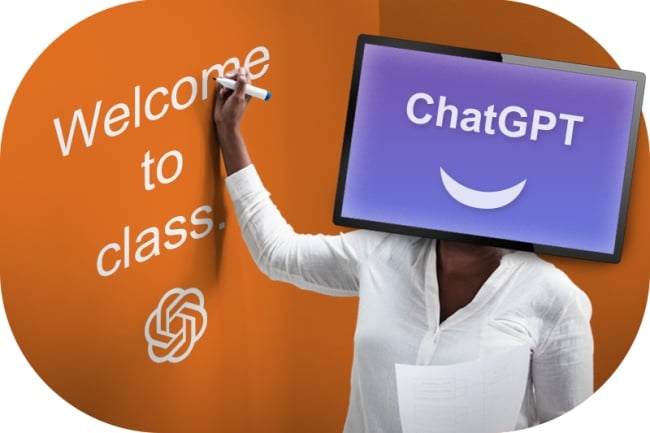You have /5 articles left.
Sign up for a free account or log in.

Some professors are introducing courses focused solely on ChatGPT.
Photo illustration by Justin Morrison/Inside Higher Ed | Photos: Rawpixel
Andrew Maynard has studied cutting-edge technology for nearly two decades and tracked the rise of generative artificial intelligence from the start. As interest in AI intensified, he knew he had to release an offering for students—and fast.
“We got to the point where it was very clear to me [that] there was a lot of panic, a lot of intrigue and things were moving fast,” said Maynard, a professor at Arizona State University’s School for the Future of Innovation in Society.
In April he began planning to offer a course now known as Basic Prompt Engineering With ChatGPT. Prompt engineering, like the name suggests, focuses on creating the most useful text prompts—in this case, for ChatGPT—that yield the best answers from the AI chat bot.
The first version of the course launched this month, with another class set for the fall. Maynard pushed back on the notion that creating the course moved at a breakneck speed, given the challenges of academic bureaucracy.
“It was the opposite of too fast,” he said. “I was paranoid by the time we started teaching this it would be outdated.”
Maynard, along with Jules White at Vanderbilt University, are among a small number of professors launching courses focused solely on teaching students across disciplines to better navigate AI and ChatGPT.
The offerings go beyond institutions flexing their innovation skills—the faculty behind these courses view them as imperative to ensure students are prepared for ever-changing workforce needs.
“This is our duty to students to do everything we can to help them succeed in this new world,” said White, director of the Vanderbilt Initiative of the Future of Learning and Generative AI. “People are saying, ‘Generative AI is taking your job’—if that’s the case, we better do something about it and make sure students are innovating and succeeding.”
Launching the ChatGPT Courses
Nashville-based Vanderbilt dipped its toe into the ChatGPT pool in May with its Prompt Engineering for ChatGPT course on online course provider Coursera. While more than 76,000 people—mostly professionals—have taken that course, White wanted something specifically geared toward students.
“This is going to be one of the foundational skills people will have to have going forward,” he said. “This will affect every domain, every discipline, and it’s really important we teach it.”
The university is launching an undergraduate course on generative AI that is open across majors. White expects the class’s 60 spots will be maxed out.
White said the benefits of ChatGPT will be applied across disciplines, ranging from music to medicine. A French professor, for example, is having students generate dialogue from participants in the French Revolution, then assesses its historical and language accuracy; the medical school could have students diagnose ChatGPT’s medical ailment, and teachers can use it in lesson planning.
“We have to make sure people know how to work effectively with it and appropriately, knowing what works, what are the problems,” White said.
Maynard took a bit of a different approach when he created his course, going straight to the source. He asked ChatGPT itself to create a course outline on best utilizing the AI tool. While the course was not solely designed by ChatGPT—Maynard had faculty weigh in on the content, and a graduate student worked through the entire course to test it—the technology did help put a framework in place.
The course, which kicked off earlier this month, is held entirely online and will span six and a half weeks for its 72 students.
Both White and Maynard acknowledge that most universities could not execute the quick turnaround. They attribute the speediness in part to their respective universities’ innovative environments.
“We’re a novelty because we move so fast; universities tend to be more conservative in what they teach, and rightly so,” Maynard said. “Because you can’t chase after every bright new idea. But this is different: the writing is on the wall.”
Other Universities’ AI Efforts
Many universities, however, find the idea of balancing their course load while monitoring developing technology daunting, according to Derek Bruff, visiting associate director at the Center for Excellence in Teaching and Learning at the University of Mississippi. He suggested, in those cases, turning toward outside experts for guidance.
“[Faculty] are teaching five courses; it’s a lot of heavy lifting, so having folks like me who can do some of the leg work of ‘Here’s six good strategies to adopt’—it’s helpful for faculty who are pressed for time and want to teach well,” he said.
Bruff said he’s seen a spike in interest from institutions wanting him to speak on AI, versus a more general technology talk, and he expects those requests to increase. It’s been an evolution, from first being asked to discuss the policy of AI to now looking at use cases.
“Now it’s a horse-out-the-barn situation of ‘It’s everywhere; how do we redesign our courses and assignments to account for these tools?’” he said.
You can’t chase after every bright new idea. But this is different: the writing is on the wall.
—Andrew Maynard, professor at Arizona State University’s School for the Future of Innovation in Society
While many university systems are intimidated by completely overhauling their programs, Bruff suggests bringing faculty within their departments together to discuss potentially incorporating the technology into courses, to some extent, this fall.
Many are doing just that. Pamela Bourjaily, associate professor of business communication at the University of Iowa, created a formula for better ChatGPT prompts after assigning students to find weaknesses in the technology.
Diane Gayeski, a professor of strategic communications at Ithaca College, and Ethan Mollick, entrepreneurship professor at the University of Pennsylvania’s Wharton School, both require students to use ChatGPT for their coursework.
Others are focused on the professionals in their community, offering certificates, courses and workshops to teach the ways the technology can be used in the workplace. The Tampa-based University of South Florida, for example, launched an AI in the Workplace certificate program in 2022; Stanford University offers a one-time course titled Getting Started With ChatGPT for a $300 flat rate.
White said adoption is imperative, believing the technology will soon become ubiquitous.
“You’re either somewhere that’s innovating and enhancing because of the tools, and it’ll be an exciting time of new ideas,” he said. “Or you’re an institution trying to hold onto old quiz questions. And it’ll be a stressful, strange time when you’re fighting the evolution of the world with these AI-driven systems.”





